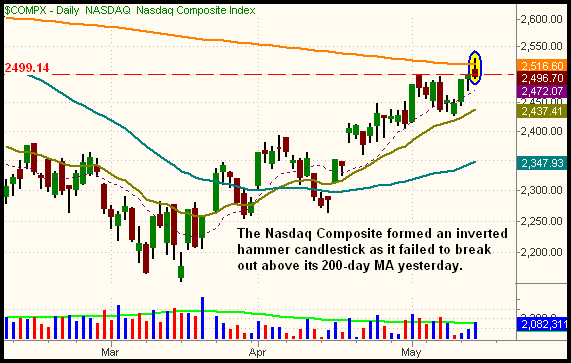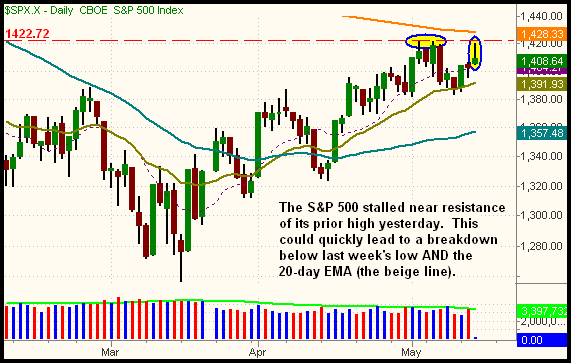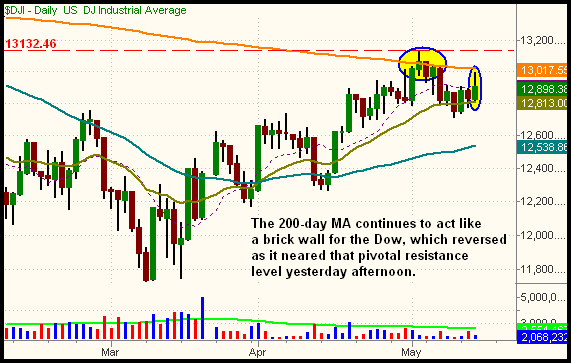|
The Wagner Daily ETF Report For May 15
Stocks got off to a positive start yesterday morning, moved higher throughout most of the day, then fell victim to a bearish reversal in the final ninety minutes of trading. Resistance of the Nasdaq Composite's 200-day moving average was a major culprit of the broad market's late-day weakness. Up 1.3% at its intraday high, the Nasdaq Composite finished just 0.1% higher. The S&P 500 and Dow Jones Industrial Average, both of which experienced similar selling into the close, still retained gains of 0.4% and 0.5% respectively. The S&P Midcap 400 ticked 0.2% higher, as the small-cap Russell 2000 slipped 0.1%. The tech-heavy Nasdaq 100 Index also showed relative weakness by losing 0.2%. All the major indices settled near their lowest levels of the session.
Total volume in the NYSE was 1% lighter than the previous day's level, while volume in the Nasdaq rose 12%. Although the Nasdaq Composite technically gained on increasing volume, it would be misleading to label yesterday's action as a bullish "accumulation day." Aside from the 0.1% gain being too minimal, it's bearish that the index gave up a much larger intraday gain and closed at its worst level of the day. In healthy markets, intraday weakness often leads to closing prices near the highs. Yesterday's action was the opposite.
In yesterday's Wagner Daily, we pointed out bullish setups in the following ETFs: Market Vectors Russia ETF (RSX), iShares Latin America (ILF), Market Vectors Coal ETF (KOL), and Ultra QQQ ProShares (QLD). On an intraday basis, every one of those ETFs was showing a nice gain through the early afternoon, but the picture quickly changed when late-day selling hit the market. By the closing bell, ILF and QLD had failed their breakout attempts. KOL posted a 1.6% closing loss. RSX, which we bought shortly after yesterday's open, bucked the trend by retaining much of the day's gains. Nevertheless, we made a judgment call to bail on RSX and lock in a small intraday profit when we noticed the intensity of the broad-based selling.
Novice traders and investors who only looked at yesterday's closing prices, not the details of what happened "under the hood," might have been fooled into thinking yesterday's session was mildly positive. On the contrary, we found yesterday's price to volume relationship in the Nasdaq to be quite bearish and indicative of "churning." When you step on the accelerator of a powerful car too quickly, the wheels will spin, but the car goes nowhere. This is similar to what happened in the Nasdaq; trading activity picked up, but prices were little changed.
Churning like stocks experienced yesterday typically occurs when institutions stealthily sell into strength of a rally. By waiting for an intraday gain to sell into, mutual funds, hedge funds, and other institutional players are able to disguise their actions from those who don't know any better. Fortunately, however, volume is one of the few technical indicators that never lies. Observing the relationship between the stock market's closing prices and its changes in day-to-day volume is the best way to detect the footprints of institutional activity. It's critical to know what the "smart money" is doing on a daily basis because a vast majority of the stock market's average daily volume is the result of institutional trading. Just as water flowing down a hill will always follow the path of least resistance, so will the stock market.
Due to divergent chart patterns between the Nasdaq and the S&P/Dow, the broad market was showing mixed signals going into yesterday morning. Specifically, we discussed that the Nasdaq Composite was positioned to break out to a new intermediate-term high, but both the S&P 500 and Dow Jones Industrial Average were still in danger of forming "lower highs" on their daily charts, after dropping to support of their 20-day exponential moving averages last week. Such price divergence within the major indices often leads to whippy price action, resulting from a tug-of-war between the bulls and bears. The good news, however, is that yesterday's price action now brings the near-term technical view into better focus, albeit with a decidedly more negative view.
Yesterday, the Nasdaq did what it was "supposed to do" by breaking out above its recent consolidation and testing its 200-day MA, attracting the buying interest of the bulls in the process. But when institutions sold into strength during the final ninety minutes, bulls who bought the breakout started to become trapped, further fueling the late day slide. By the time the dust had settled, the Nasdaq had formed a bearish "inverted hammer" candlestick on its daily chart, along with a failed breakout above the 200-day MA. This is shown below:

In and of itself, the inverted hammer pattern on the chart above is bearish, and often leads to lower prices in the days that follow. Key resistance of the 200-day MA further increases the odds of additional downside in the near-term. The "lower highs" that may formed on the daily charts of the the laggard S&P 500 and Dow Jones Industrial Average may also weigh on the Nasdaq. If both the S&P and Dow fail to rally above yesterday's highs within the next several days, odds are good that the next near-term move will be a break of last week's lows, as well as their 20-day EMAs. The lower highs are shown on the daily charts of the S&P and Dow below:


Yesterday's churning that led to inverted hammer candlesticks on a plethora of stocks, ETFs, and indexes is a warning sign to astute traders. Further, the timing was such that the S&P and Dow both stalled near resistance of their prior highs. Though the stock market has not yet proven it has formed an intermediate-term top, the bears have been regaining more control since last week's correction began. A clear break of last week's lows in any of the major indices could be the nail in the coffin that leads to an end of the counter-trend bounce off the March lows. A resumption of the long-term downtrends that began in October 2007 could follow. Remember the big picture; the major indices remain in primary downtrends until they prove otherwise. Professional traders who "trade what they see, not what they think" should consider trailing tighter stops to protect their gains on open long positions.
Open ETF positions:
Long - DXD, UUP
Short - (none)
Deron Wagner is the Founder and Head Trader of both Morpheus Capital LP, a U.S. hedge fund, and Morpheus Trading Group, a trader education firm launched in 2001 that provides daily technical analysis of the leading ETFs and stocks. For a free trial to the full version of The Wagner Daily or to learn about Wagner's other services, visit MorpheusTrading.com or send an e-mail to deron@morpheustrading.com.
|